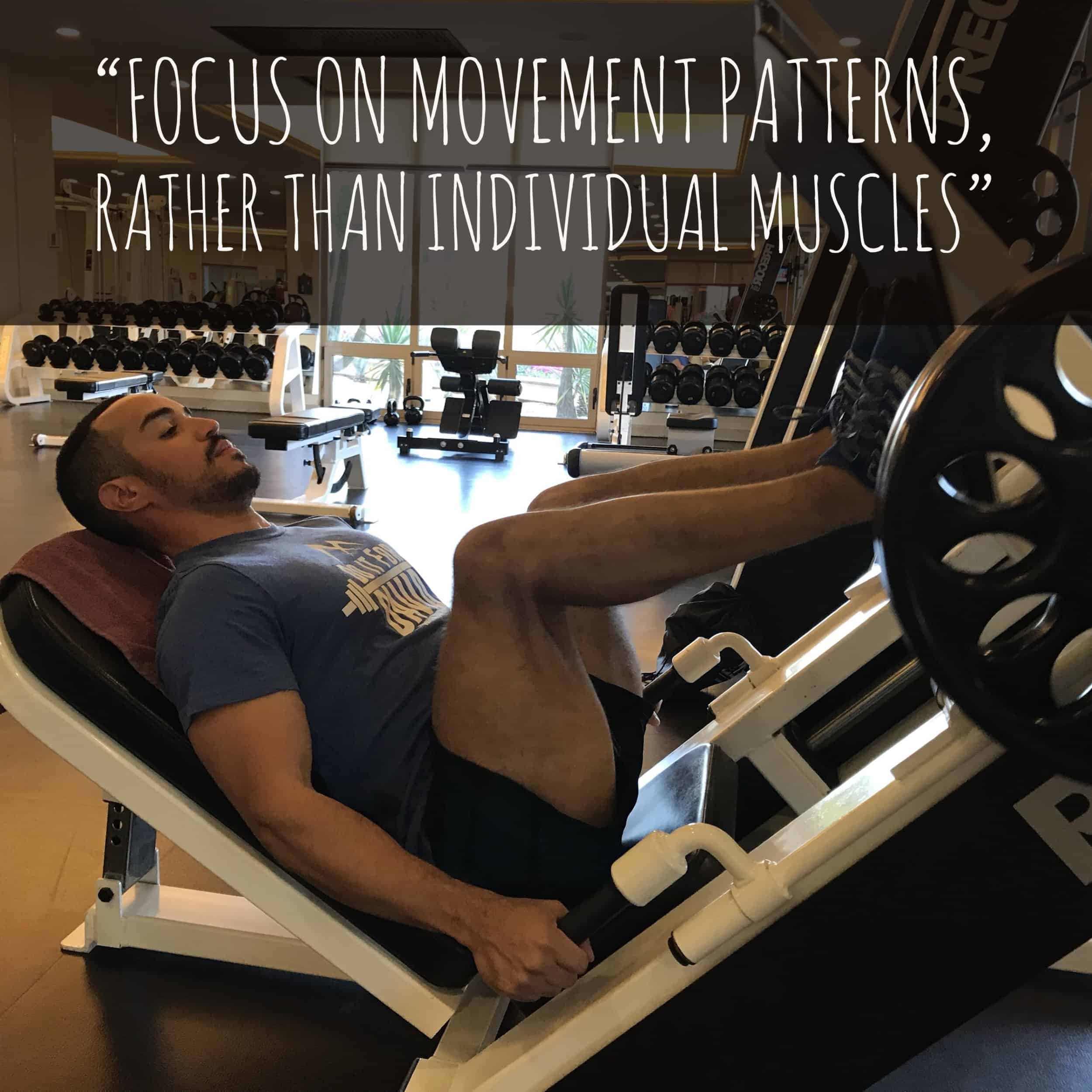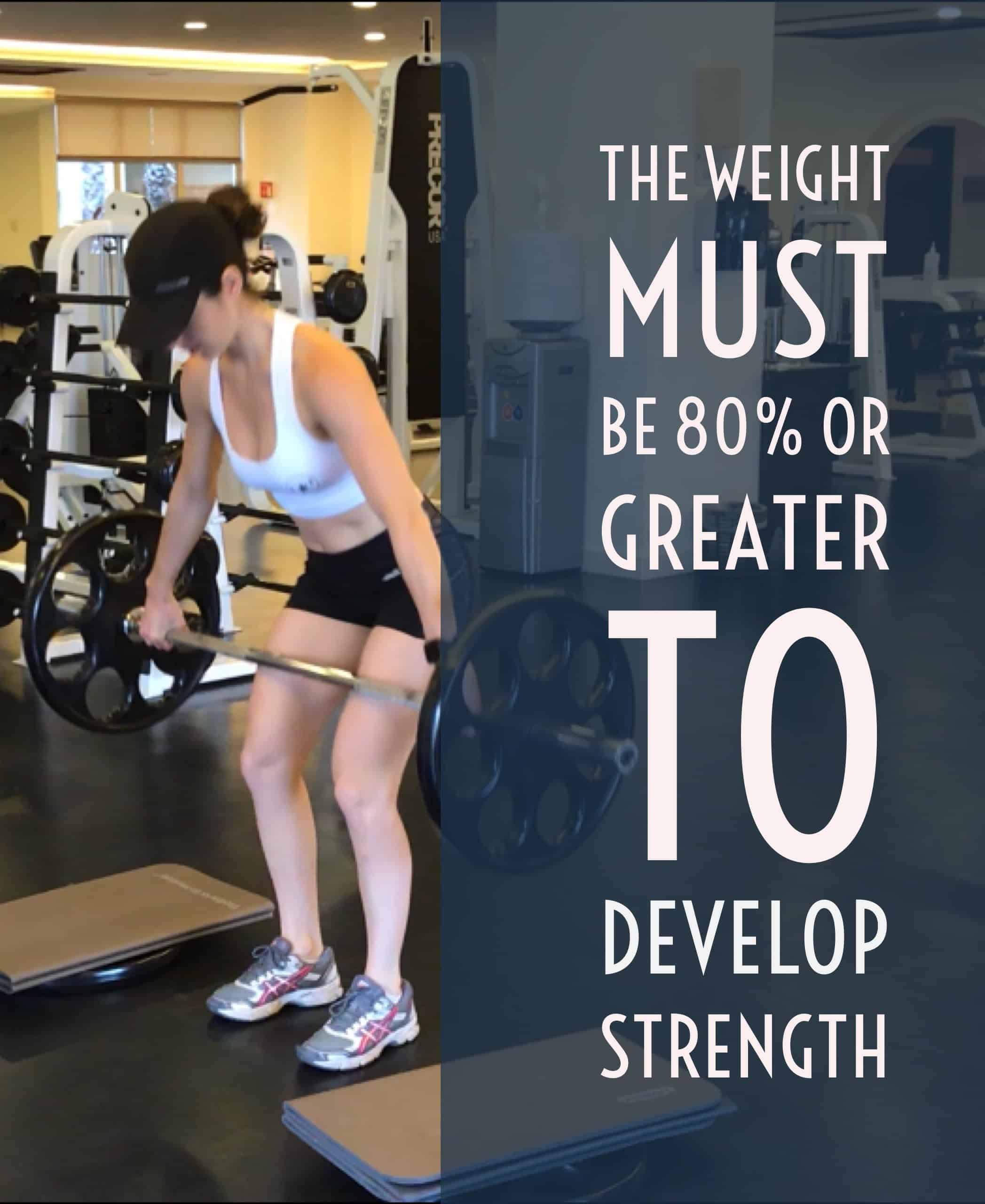Strength vs hypertrophy: Which one should you focus on?
After reading this post, you’ll learn:
- When and how to include strength training & hypertrophy training in your routine,
- If you should do strength or hypertrophy first, and
- The most important thing you can do to maintain long-term progress.
These are the strategies that I have used to add over 25 lbs of muscle to my frame, and almost triple my strength.
Let’s get started!

What Is The Difference Between Strength And Hypertrophy?
Hypertrophy training is exercising for the purpose of growing bigger muscles. (i.e increasing muscular size).
Strength training is exercising for the purpose of making your muscles stronger. (I.e, being able to lift more weight).
While they might sound similar, you can change your training style to target different goals.
This is done by changing the number of sets, reps, and amount of weight you lift.
Which Is Better?
Neither strength nor hypertrophy is better, as both are necessary to improve your health and fitness.
Hypertrophy training involves the use of lighter weight and more repetitions. This will allow you to learn proper form and build up muscular endurance.
Strength training requires the use of heavier weight, which decreases the number of repetitions you can do.
The one you should do depends on your lifting experience and your training goals.
If you are a beginner, focus more on hypertrophy.
Does Hypertrophy Make You Stronger?
A bigger muscle always has the potential to be a stronger muscle. So yes, hypertrophy training will make you stronger to a certain extent.
However, you won’t ever achieve your maximal strength if you never train with heavy weight.
This is why powerlifters and olympic weightlifters are much stronger than bodybuilders, despite being much smaller.
More on that later.
Does Strength Matter For Hypertrophy?
On that same token, strength training will also build muscular size to an extent.
Getting stronger requires you to teach your nervous system to recruit more motor units at any given time.
But once you reach a certain level, strength training won’t continue to increase the size of your muscles.
The main determinant of muscle growth is total volume. (Aka the number of sets and reps you do).
In general, you won’t be able to do a lot of volume if you only train for muscle strength all the time.

Should I Train For Strength or Hypertrophy First
So what should you do as a beginner? Strength or hypertrophy first?
If you are a beginner, you should always train for hypertrophy first.
By using the hypertrophy rep range in your early career, you will be building muscle AND gaining strength.
Take your time to develop some muscle mass, learn the proper technique, and gain confidence under the bar.
The loads required for strength training can challenge your technique, and cause lead to muscular and joint injuries if not used properly.
With that said, once you become an intermediate- you can train for both strength and hypertrophy.
Can I Do Both Strength and Hypertrophy At The Same Time?
It is possible to train for muscular strength and muscular hypertrophy in the same training session.
Her;es how:
- Your Primary Movement (aka main lift) of the day is trained heavy in the 4-6 rep range.
- This has to be the biggest compound exercise of the day (such as squats, deadlifts, bench press, shoulder press etc)
- Your secondary exercises are then trained in the hypertrophy range, usually in the 8-15 rep range
- These exercises are generally less taxing and generally do not need a barbell. Common examples include dumbbell pressing, goblet squats, dumbbell Romanian deadlift.) Some would call these accessory or assistance exercises.
What Sets & Reps Do You Need For Hypertrophy & Strength
According to the research, lower loads with higher volumes tend to lead to higher amounts of muscle growth.
That’s because the amount of time your muscles are under tension (aka longer sets) appears to be the biggest factor in causing muscle growth.
So here are the sets and reps you need to do.
The Optimal Rep Range For Hypertrophy
- Performing 7-12 repetitions per set have been shown to be the most conducive to muscular growth.
- When it comes to sets, 3 is generally a good place to start. 3 sets of 7-12 reps equate to a total of 21-36 repetitions per exercise per day.
- Since we recommend that you train each major movement pattern twice a week, you’ll be doing 42-72 total reps, per muscle group, per week.
It is extremely important that you focus on movement patterns, rather than individual muscles. Movement patterns represent compound exercises, and these hit multiple muscle groups simultaneously.
For example, let’s say you:
- Front Squat 3 sets of 8 repetitions once a week
- Goblet Squat 3 sets of 10 repetitions later that week
- And Reverse Lunges 3 sets of 12 repetitions once during that week
That is a total of 9 sets and 90 repetitions of Quadriceps Work per week, WITH the added bonus of hitting your glutes and your hamstrings for 9 sets indirectly as well.

Why Should You Train For Hypertrophy?
- Hypertrophy causes your muscle fibers to grow in size.
- More size means more potential strength and athleticism.
- More muscle size means more metabolically active tissue. More metabolically active tissue means more fat burning potential.
How Often Should You Train For Hypertrophy?
- I recommend that you train in the Hypertrophy range for most of your early training career.
- At least 2/3rds of your exercise programming should be dedicated to hypertrophy.
Alright that’s all for hypertrophy for now.
Let’s move on to strength.
Section Recap:
- Hypertrophy training is dedicated to the development of muscular size
- It requires the use of low to moderate loads with high repetitions
- Dedicate 2/3 of your total training towards hypertrophy training
The Optimal Training Volume For Strength
Since strength training requires you to lift heavier weights, you will not be able to perform as many sets and reps as you can with hypertrophy training.
Volume and intensity are inversely proportional. The heavier the load you are lifting, the less volume you will be able to do.
The weight that you use for strength training must be heavy enough to induce muscular fatigue at around 5 reps or less per set.
Train for strength only after you have developed a decent baseline of strength and comfort with the basic functional compound lifts.
The Optimal Rep Range For Strength
- Performing 4-6 repetitions per set is most conducive to muscular strength
- Because the load on the bar increases, the repetitions per set decreases.
- This means that strength training often requires more sets than hypertrophy training. Usually 3-4 sets per exercise.
Most importantly, the weight needs to be challenging.
How heavy should the weight be?
The weights should be ~80% or more of your one rep max.

Your one-rep max is the most weight that you can lift for one repetition with good technique.
Again, this bears repeating…
It is important to note that the really heavy weights should be reserved for experienced lifters who have developed great technique on the various lifts.
Use your judgment.
If you cannot maintain good form when performing the exercise, it’s probably a good idea to decrease the weight.
Why Should You Train For Strength?
Strength is one of those characteristics that are useful for anyone in any situation. When you train for strength you
- Train your central nervous system to recruit more neural motor units to lift more weight.
- Stronger muscles will also let you break through plateaus you may experience during hypertrophy training, which inevitably happens if you only train in the 7-12 rep range.
- Lastly, you never know when you may have to save someone who is pinned under a car.
General Guidelines
- In total, you should perform around 12-24 repetitions per exercise, per day when training for strength.
- Each major movement pattern should be trained ~twice a week, totaling 24-48 total reps per week.
- The weight must be ~80% of your 1 Rep Max or more
If you aren’t an experienced lifter (at least 2-3 years of consistent exercising), you should spend no more than 1/3rd of your training on strength gain.
The more experienced you are, the more strength training you can and should do.
How strong should you be?
Check out our strength standards for busy people so you can set some realistic strength goals for yourself.
Section Recap:
- To train for strength, use weights that are ~80% of your 1 rep max
- Do 3-4 sets of 4-6 reps
- Strength training should make up 1/3 of your total training
Strength Vs Hypertrophy Physique
The biggest person may not necessarily be the strongest person.
In fact, the people with the most amount of skeletal muscle mass (professional bodybuilders) are nowhere near as strong as the strongest athletes (powerlifters, Olympic lifters, and strongmen) despite being “bigger.”
Here are some extreme examples of physiques you might see in athletes who train for maximal hypertrophy vs maximal strength.

Why is this the case?
This is a byproduct of the way you train.
If you want to be strong, then you must dedicate a portion of your workout routine to strength training.
What About Muscle Fiber Type? Does That Influence Hypertrophy & Strength?
There are three different types of skeletal muscles, which are beautifully described in this video.
The leading theory is that Type 1 (or slow twitch) muscle fibers respond best to hypertrophy training, aka high reps low weight, and that Type II (fast twitch) respond best to strength or power training, aka low reps high weight.
However, it appears that most muscles are composed of both types of muscle fibers, and aren’t all type 1 or type 2.
In addition, it is impossible to tell whether your particular muscles are predominantly type 1 or type II. Therefore, trying to train each muscle based on its type should not be your priority.
The bottom line?
All muscles should be trained through a variety of different rep ranges.
The Most Important Strategy To Make Long Term Progress
Now that you have an idea for the appropriate amount of training volume you need for muscular size and strength, let’s talk about long-term progress.
As we discussed in Part 1, the training stimulus must be progressive or increasing over time.
The easiest way to do this is to increase the weight you are lifting over time, or to increase the repetitions you are doing at a particular weight over time.
In short, you must do a little bit more than you did before.
This is the entire concept of Progressive Overload.
Obviously, this cannot go on forever. If you try to do this continuously, your body will plateau, or you will get injured.
So how do we bypass this?

The easiest way to circumvent this problem is to keep rotating the exercises that you are performing every 8-12 weeks in your weight training.
Constantly doing the same exercise over and over with increasing weights or increasing reps can eventually lead to overuse injuries and pain.
Focus only on 1-2 variations of an exercise at a time, and then switch them every 8-12 weeks.
For Example
- Week 1-8: Bench Press and Incline Dumbbell Bench Press
- Week 9-19: Close Grip Bench Press and Wide Grip Push-ups
- Week 20-28: Incline Bench Press and Dumbbell Bench Press
- Week 29-36: Weighted Push-ups and 3-count paused Bench Press
- Week: 37: Restart
And for the Squat Pattern
- Week 1-12: Squat and Reverse Lunges
- Week 13-20: Box Squats and Leg Press
- Week: 21-32: Front Squat and Step Ups
- Week: 33-40: Paused Back Squat and Goblet Squats
- Week 41: Restart
By rotating the exercises, you are training your muscles in different ways and forcing them to adapt to new stimuli every 2-3 months. You build better overall strength and keep your training fun and engaging.
Keep track of your progress for every exercise in a journal or electronic notepad.
Every time you return to a variation you have previously done, compare your new levels of strength to where you were before.
Get stronger in every variation possible. Keep the long-term picture in mind.
Other Related Questions
What Is The Difference Between Sarcoplasmic & Myofibrillar Hypertrophy?
According to some theories, there are two types of hypertrophy.
Myofibrillar Hypertrophy & Sarcoplasmic Hypertrophy
- Sarcoplasmic hypertrophy refers to growth of the sarcoplasm, or the fluid surrounding the actual muscle cells.
- Myofibrillar hypertrophy refers to an increase in the actual number of muscle contractile proteins, aka the myofibrils
As such, the theories state that sarcoplasmic hypertrophy makes your muscle look bigger, whereas myofibrillar hypertrophy is what makes you stronger.
It is often thought that sarcoplasmic hypertrophy can be obtained through using lighter weights, higher repetitions, and more volume and vice versa for myofibrillar hypertrophy.
At this time, there does’t appear to be any scientific evidence that sarcoplasmic hypertrophy, actually contributes to actual “real” visible hypertrophy in the long run.
Muscular growth is a natural adaptation of your training, and using different volumes and intensities is what will contribute most to your progress.
What About Strength vs Hypertrophy vs Endurance?
Similar to strength and hypertrophy training, you can change your sets and reps scheme to focus on endurance training.
In general, endurance training requires
- Higher volume (which could be more sets and/or more reps)
AND
This will keep the time under tension of your muscles as well as your oxygen requirements high. This will ultimately induce a cardiovascular and metabolic conditioning benefit to your muscles.
Building muscle endurance is what will allow you to not fatigue during long distance events.
Check out my post on HIIT to learn more.
And Strength Vs Hypertrophy Vs Power?
Power refers to how fast you can move a weight across a certain distance.
In general, power training generally uses sets in the 1-3 rep range, as these type of explosive exercises require maximal force on ever rep.
Power training more closely resembles strength training, and has very little overlap with hypertrophy training.
Common power exercises include the olympic lifts: such as cleans, snatches, and jerks.
Which is Better For Fat Loss?
All things being equal, hypertrophy training is better than strength training for fat loss. That’s because you can perform more overall volume doing hypertrophy, which in turn, will burn more calories.
With that said, exercise alone will never help you burn fat. Your diet is a necessary factor that you must optimize if your goal is fat loss.
I go over more details in Diet Vs Exercise- Whats More Important?
A Complete Hypertrophy & Strength Program
Now that we have covered all of the important topics related to gym workouts, you can go and check out the WCT Strength Programs For Busy Professionals.
It is a ready-made 15-week training template that uses all of the principles laid out in this article and more.
And the best part?
The workouts are designed to be completed in 30-35 minutes a day.
Be sure to check it out here.
The Bottom Line On Creating A Strength & Hypertrophy Split For Long Term Progress
Any health and fitness professional would agree that improving your lean muscle mass percentage is extremely beneficial for just about everyone.
In order to reap the maximum benefit of your exercise program, it is ideal to increase your muscular size and your muscular strength.
To Recap:
- You can train for strength and hypertrophy by using the right number of reps in your exercise program.
- The majority of your training should be dedicated to hypertrophy training, especially if you are a beginner.
- Strength training should also be included in your routine, but after you have developed confidence in the major functional movements
- Heavier weight = fewer reps = less total volume
- Lastly, do not forget the importance of being well-rounded. Rotate the exercises you include in your training every 2-3 months while still improving all 6 movement patterns.
Next you should read
- The Best Workout Template For Busy Professionals
- The Ultimate List of Compound Gym Exercises
- The Ultimate List of Calisthenic Bodyweight Exercises
Now we turn it over to you:
Have you primarily trained for hypertrophy or strength?
Comment below and let us know.

Alex Robles, MD, CPT / Brittany Robles, MD, MPH, CPT
Alex & Brittany Robles are physicians, NASM Certified Personal Trainers, and founders of The White Coat Trainer: a resource dedicated to improving the health and fitness of busy professionals using time-efficient strategies. Their advice has been featured in My Fitness Pal, Prevention, Livestrong, Reader’s Digest, Bustle, The Active Times, and more. Learn more about them here.
References:
- Burd NA, West DW, Staples AW, Atherton PJ, Baker JM, Moore DR, Holwerda AM, Parise G, Rennie MJ, Baker SK, Phillips SM. Low-load high volume resistance exercise stimulates muscle protein synthesis more than high-load low volume resistance exercise in young men. PLoS One. 2010 Aug 9;5(8):e12033. doi: 10.1371/journal.pone.0012033. PMID: 20711498; PMCID: PMC2918506.
- Burd NA, Andrews RJ, West DW, et al. Muscle time under tension during resistance exercise stimulates differential muscle protein sub-fractional synthetic responses in men. J Physiol. 2012;590(2):351-362. doi:10.1113/jphysiol.2011.221200
- Schoenfeld BJ. The mechanisms of muscle hypertrophy and their application to resistance training. J Strength Cond Res. 2010 Oct;24(10):2857-72. doi: 10.1519/JSC.0b013e3181e840f3. PMID: 20847704.

Never seen anyone break down training for different body types. Usually the body types are only in reference to diet.
I of course want both size and strength. Popular term now is "powerbuilding". Easier said than done after a few years of serious training. I really do want to hit a 405 squat next year while staying under 175.
Are you running a specific program? Like 5/3/1, cube, Juggernaut, etc…
Hey Grant
Yea I’ve noticed it on myself and others who I have trained that different body types can handle different types of training regimens.
And yes, I agree with you. Power building has become very popular over the last couple of years. We are starting to learn that it is important to have both components in your training, no matter how much experience someone may have.
I definitely think that you can hit 405 at 175. Usually technique is the first thing i look at when someone is struggling to gain strength. Do you feel that your squat form is solid?
Currently I am running a hybrid program that I create for myself and my wife. It takes príncipes from all of the lifting programs that I have done or read about (including block periodization, 5/3/1, Mike Tuscherers RPE System) etc.